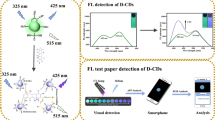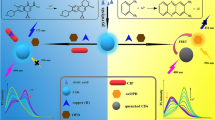Abstract
The one-step synthesis of Mn-doped carbon quantum dots (Mn-CPDs) with a high quantum yield (QY = 45%) is reported using the microwave-assisted method. Subsequently, Mn-CPDs were successfully combined with Eu3+ ions to construct an Eu3+@Mn-CPDs fluorescence sensor. The presence of tetracycline (TC) induced a transition of fluorescence emission from blue (434 nm) to red (618 nm), and a robust linear relationship was observed between the ratio of F618 nm / F434 nm and the TC concentration (5 − 50 nmol/L), with a limit of detection (LOD) of 5.76 nmol/L. The underlying mechanism of Eu3+@Mn-CPDs and TC sensing is unveiled as a synergistic effect involving inner filter effect (IFE) and concurrent interactions. Notably, the smartphone-integrated sensing platform based on Eu3+@Mn-CPDs enables rapid and quantitative TC detection within a short time (< 30 s) by monitoring fluorescence color changes, achieving high-detection sensitivities (with a LOD of 6.18 nmol/L). This versatile and efficient sensing platform demonstrates its potential for the determination of TC concentrations in milk, honey, and tap water samples.
Graphical abstract







Similar content being viewed by others
Data Availability
The datasets generated during and/or analysed during the current study are not publicly available due [REASON WHY DATA ARE NOT PUBLIC] but are available from the corresponding author on reasonable request.
References
Ajiboye TO, Sawunyama L et al (2023) Synthesis approaches to ceramic membranes, their composites, and application in the removal of tetracycline from water. Environ Adv 12. https://doi.org/10.1016/j.envadv.2023.100371
Afshinnekoo E, Bhattacharya C et al (2021) COVID-19 drug practices risk antimicrobial resistance evolution. Lancet Microbe 2(4):e135–e136. https://doi.org/10.1016/S2666-5247(21)00039-2
Ahmad M, Rajapaksha AU et al (2014) Biochar as a sorbent for contaminant management in soil and water: a review. Chemosphere 99:19–33. https://doi.org/10.1016/j.chemosphere.2013.10.071
Ahmed MB, Zhou JL et al (2015) Adsorptive removal of antibiotics from water and wastewater: progress and challenges. Sci Total Environ 532:112–126. https://doi.org/10.1016/j.scitotenv.2015.05.130
Guerra W, Silva-Caldeira PP et al (2016) Impact of metal coordination on the antibiotic and non-antibiotic activities of tetracycline-based drugs. Coord Chem Rev 327–328:188–199
Ahumada-Rudolph R, Novoa V et al (2021) Mycoremediation of oxytetracycline by marine fungi mycelium isolated from salmon farming areas in the south of Chile. Food Chem Toxicol 152. https://doi.org/10.1016/j.fct.2021.112198
Liu F, Myers AG (2016) Development of a platform for the discovery and practical synthesis of new tetracycline antibiotics. Curr Opin Chem Biol 32:48–57. https://doi.org/10.1016/j.cbpa.2016.03.011
Ahmed MB, Rajapaksha AU et al (2015) Distribution and accumulative pattern of tetracyclines and sulfonamides in edible vegetables of cucumber, tomato, and lettuce. J Agric Food Chem 63(2):398–405. https://doi.org/10.1021/jf5034637
Nguyen F, Starosta AL et al (2014) Tetracycline antibiotics and resistance mechanisms. Biol Chem 395(5):559–575. https://doi.org/10.1515/hsz-2013-0292
Zhao Z, Sun L et al (2023) Polymer-derived carbon materials for energy storage devices: a mini review. Carbon 210. https://doi.org/10.1016/j.carbon.2023.118066
Ru Y, Ai L et al (2020) Recent advances in chiral carbonized polymer dots: from synthesis and properties to applications. Nano Today 34. https://doi.org/10.1016/j.nantod.2020.100953
Feng Z, Adolfsson KH et al (2021) Carbon dot/polymer nanocomposites: From green synthesis to energy, environmental and biomedical applications. Sustain Mater Technol 29. https://doi.org/10.1016/j.susmat.2021.e00304
Singh A, Thakur S (2023) Recent advancements in the fabrication of transition metal dichalcogenides-polymer nanocomposites: Focused on molybdenum selenide for various applications. Mater Today Chem 30. https://doi.org/10.1016/j.mtchem.2023.101562
Innocenzi P, Stagi L (2023) Carbon dots as oxidant-antioxidant nanomaterials, understanding the structure-properties relationship. A critical review. Nano Today 50. https://doi.org/10.1016/j.nantod.2023.101837
Li D, Qu Y et al (2023) Supra-(carbon dots) with versatile morphologies and promising optical properties. Chem Eng J 454. https://doi.org/10.1016/j.cej.2022.140069
Korah BK, Thara CR et al (2023) Microwave abetted synthesis of carbon dots and its triple mode applications in tartrazine detection, manganese ion sensing and fluorescent ink. Food Control 147. https://doi.org/10.1016/j.foodcont.2023.109608
Torres Landa SD, Reddy Bogireddy NK et al (2022) Heavy metal ion detection using green precursor derived carbon dots. iScience 25(2):103816. https://doi.org/10.1016/j.isci.2022.103816
Bhattacharjee T, Konwar A et al (2023) A sustainable approach for heavy metal remediation from water using carbon dot based composites: a review. J Hazard Mater Adv 10. https://doi.org/10.1016/j.hazadv.2023.100295
Rong M, Liang Y et al (2018) A ratio metric fluorescence visual test paper for an anthrax biomarker based on functionalized manganese-doped carbon dots. Sens Actuators, B Chem 265:498–505. https://doi.org/10.1016/j.snb.2018.03.094
Gencer O, Çeven ÖF, Ünlü C (2022) Triggering excitation independent fluorescence in zinc(II) incorporated carbon dots: Surface passivation of carbon dots with zinc(II) ions by microwave assisted synthesis methods. Diamond Relat Mater 123. https://doi.org/10.1016/j.diamond.2022.108874
Wu H, Chen Y et al (2023) Dual-response fluorescent probe based on nitrogen-doped carbon dots and europium ions hybrid for radiometric and on-site visual determination of oxytetracycline and tetracycline. Sci Total Environ 860:160533. https://doi.org/10.1016/j.scitotenv.2022.160533
Shen Y. Wei H et al (2022) Liposome-encapsulated aggregation-induced emission fluorogenic assisted with portable smartphone for dynamically on-site imaging of residual tetracycline. Sensors Actuators B: Chem 350. https://doi.org/10.1016/j.snb.2021.130871
Zhang X, Peng J et al (2023) Synthesis of cellulose nanofibrils modified with carbon dots-graft-polyacrylamide/ZIF-8 composite hydrogel for simultaneous adsorption and detection of tetracycline. Chem Eng J. https://doi.org/10.1016/j.cej.2023.144087
Jia L, Chen R et al (2021) A stick-like intelligent multicolor nano-sensor for the detection of tetracycline: the integration of nano-clay and carbon dots. J Hazard Mater 413:125296. https://doi.org/10.1016/j.jhazmat.2021.125296
Venugopalan P, Vidya N (2023) Microwave-assisted green synthesis of carbon dots derived from wild lemon (Citrus pennivesiculata) leaves as a fluorescent probe for tetracycline sensing in water. Spectrochim Acta A Mol Biomol Spectrosc 286:122024. https://doi.org/10.1016/j.saa.2022.122024
Korah BK, Mathew S et al (2023) Dual mode detection and sunlight-driven photocatalytic degradation of tetracycline with tailor-made N-doped carbon dots. Environ Res 216(Pt 1):114450. https://doi.org/10.1016/j.envres.2022.114450
Fan YJ, Wang ZG et al (2023) A dual-signal fluorescent colorimetric tetracyclines sensor based on multicolor carbon dots as probes and smartphone-assisted visual assay. Anal Chim Acta 1247:340843. https://doi.org/10.1016/j.aca.2023.340843
Laddha H, Yadav P et al (2023) Waste to value transformation: Converting Carica papaya seeds into green fluorescent carbon dots for simultaneous selective detection and degradation of tetracycline hydrochloride in water. Environ Res 227:115820. https://doi.org/10.1016/j.envres.2023.115820
Wang J, An J et al (2023) High fluorescent nitrogen−doped carbon dots derived from Sanghuangporus lonicera for detecting tetracyclines in aquaculture water and rat serum samples. Microchem J 189. https://doi.org/10.1016/j.microc.2023.108517
Wang C, Sun Q et al (2022) Preparation of highly luminescent nitrogen-doped carbon quantum dots and their detection of tetracycline antibiotics. Colloids and surfaces A: Physicochemical and Engineering Aspects 653. https://doi.org/10.1016/j.colsurfa.2022.129982
Arkin K, Zheng Y et al (2023) Construction of dual-channel ratio sensing platform and molecular logic gate for visual detection of oxytetracycline based on biomass carbon dots prepared from cherry tomatoes stalk. Chemical Engineering Journal 464. https://doi.org/10.1016/j.cej.2023.142552
Cao Y, Wang X et al (2022) Fluorescent detection of tetracycline in foods based on carbon dots derived from natural red beet pigment. Lwt 157. https://doi.org/10.1016/j.lwt.2022.113100
Acknowledgements
This work is supported by the National Natural Science Foundation of China (Grant No. 52064032, 52174345, 32102073), the Yunnan Science and Technology Projects (Grant No. 202202AG050004, 202202AG050009).
Author information
Authors and Affiliations
Corresponding authors
Ethics declarations
Competing interest
The authors declare that they have no known competing financial interests or personal relationships that could have appeared to influence the work reported in this paper.
Additional information
Publisher's Note
Springer Nature remains neutral with regard to jurisdictional claims in published maps and institutional affiliations.
Supplementary Information
Below is the link to the electronic supplementary material.
Rights and permissions
Springer Nature or its licensor (e.g. a society or other partner) holds exclusive rights to this article under a publishing agreement with the author(s) or other rightsholder(s); author self-archiving of the accepted manuscript version of this article is solely governed by the terms of such publishing agreement and applicable law.
About this article
Cite this article
Han, Y., Kong, X., Gu, Y. et al. Fluorescence sensor based on optimized quantum yield manganese-carbon polymer dots and smartphone-integrated sensing platform for tetracycline detection. Microchim Acta 191, 141 (2024). https://doi.org/10.1007/s00604-024-06225-3
Received:
Accepted:
Published:
DOI: https://doi.org/10.1007/s00604-024-06225-3




